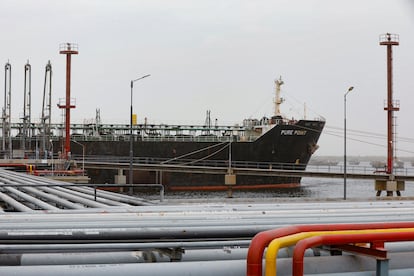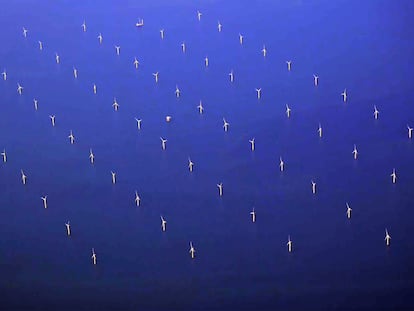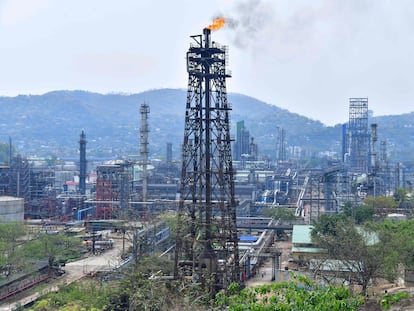The West is reluctant to revise cap on Russian oil, despite sharp rise in prices
Each barrel of crude that the Kremlin sells is already clearly above the set threshold, but the U.S. and the other non-EU members of the G7 — Canada, Japan and the United Kingdom — are refusing to introduce changes

Ukraine’s allies are shelving — at least temporarily — any plans to revise the price ceiling that has been imposed on Russia’s massive oil sales. This information, revealed by the Reuters news agency, implies that the West is completely oblivious to the recent changes in the energy market. After the recent spike in prices, most of the crude oil sold by the Eurasian country is already clearly being priced above the limit that was imposed on Moscow: $60 a barrel.
Since the price ceiling on Russian oil exports was set (in the U.S. and in most EU countries, crude oil imports from Russia are prohibited), the West debated about how much the rope should be tightened around the Kremlin’s neck. If Ukraine’s allies opted for a prudent figure, the risk was that Russia would continue to earn whatever was necessary to finance the war. However, if a more ambitious position was taken, the amount of crude oil in global circulation could have fallen drastically, resulting in gas prices going through the roof.
Half-a-year later, the balance leans towards caution: despite the recent rise in the price of Russian oil — and despite their commitment to review the cap periodically — the G7 nations have no intention of doing so in the short-term. A lowering of that threshold would increase the pressure on Moscow, but it doesn’t look like such a move is in the cards.
In August, Ural oil — the Russian benchmark — averaged at $74 a barrel, already well above the price ceiling of $60. And that figure still doesn’t reflect the growth of recent days, after both Russia and Saudi Arabia announced that they were extending the reduction of their output until the end of the year. Another indicator that reveals how the sanctions may be falling short is the price difference between European Brent and Ural crude — the true measure of the size of the blow to Moscow — which has also narrowed rapidly. “Historically, before the war, both mixtures were practically at parity. Last year, with the cap and the sanctions, the discount reached $40 per barrel. Today, we’re at around $15. That’s thanks to the cap [on Russian oil prices], although it has been less relevant than initially expected,” explains Jorge León, vice president and head of oil analysis at the Rystad Energy consultancy, in an interview with EL PAÍS by phone.
In December 2022, when the cap came into force — which was followed three months later by a price cap on Russian fuels and other derivatives of crude oil — the EU countries promised to review it every two months, adjusting it both upwards and downwards, should market conditions change. The rest of the signatories — the U.S., Canada, Japan and the United Kingdom (all of them members of the G7) and Australia — have instead chosen not to set any regular review, limiting themselves to stating that they would do so “when appropriate.”
“In June or July, there were talks about carrying out a review — or at least discussing it — but it was never formally done,” stresses a diplomatic source consulted by Reuters. According to this source, while some EU countries were in favor of lowering the threshold to increase the pressure on Russia, the U.S. and the rest of the G7 members aren’t willing to introduce changes. Within the EU, meanwhile, sentiments are also mixed: Poland and the Baltic nations have always been more favorable to tightening the screws on the Kremlin, while other EU members have maintained a somewhat more lax position, to avoid a boomerang effect against their citizens, in the form of higher prices for the crude oil and fuels that it imports.
This past March, when the first — and, to date, the last — round of talks was held to revise the cap on Russian crude, resistance from the U.S. and other non-EU countries was enough to keep it at $60. At that time, European Brent was at around $75, compared to $90 today. The differential between European and Russian barrels was $26 six months ago, far from the current $17.
Russian exporters have been trying to get around the sanctions for months. Among other methods, they have utilized a fleet of shadow tankers and an increase in their sales to large Asian countries. This strategy — along with the allies’ refusal to review the threshold — has made the sanctions less effective. “Ural crude oil has been above the ceiling for five weeks… this hasn’t been addressed,” León emphasizes. The reason? “Russia has developed its national fleet of oil tankers to be able to carry that crude — especially to Asia — and it has gotten Chinese and Indian companies to participate in the transport of that crude. And that makes the cap less effective, because Russia is able to export its crude without resorting to European services, especially British and Greek fleets.”
Sign up for our weekly newsletter to get more English-language news coverage from EL PAÍS USA Edition
Tu suscripción se está usando en otro dispositivo
¿Quieres añadir otro usuario a tu suscripción?
Si continúas leyendo en este dispositivo, no se podrá leer en el otro.
FlechaTu suscripción se está usando en otro dispositivo y solo puedes acceder a EL PAÍS desde un dispositivo a la vez.
Si quieres compartir tu cuenta, cambia tu suscripción a la modalidad Premium, así podrás añadir otro usuario. Cada uno accederá con su propia cuenta de email, lo que os permitirá personalizar vuestra experiencia en EL PAÍS.
¿Tienes una suscripción de empresa? Accede aquí para contratar más cuentas.
En el caso de no saber quién está usando tu cuenta, te recomendamos cambiar tu contraseña aquí.
Si decides continuar compartiendo tu cuenta, este mensaje se mostrará en tu dispositivo y en el de la otra persona que está usando tu cuenta de forma indefinida, afectando a tu experiencia de lectura. Puedes consultar aquí los términos y condiciones de la suscripción digital.
More information
Archived In
Últimas noticias
Trump claims peace in Ukraine is near, but Moscow suggests otherwise
A survivor’s account of the Interoceanic Train accident: ‘We were scared because of the speed on the curve’
The Interoceanic Train, the Mexican alternative to the Panama Canal
What is known about the Interoceanic Train derailment in Oaxaca
Most viewed
- Oona Chaplin: ‘I told James Cameron that I was living in a treehouse and starting a permaculture project with a friend’
- Reinhard Genzel, Nobel laureate in physics: ‘One-minute videos will never give you the truth’
- Why the price of coffee has skyrocketed: from Brazilian plantations to specialty coffee houses
- Pablo Escobar’s hippos: A serious environmental problem, 40 years on
- Chevy Chase, the beloved comedian who was a monster off camera: ‘Not everyone hated him, just the people who’ve worked with him’










































